Innocent partner of my peaceful home,
Whom ten long years’ experience of my care
Has made at last familiar, she has lost
Much of her vigilant instinctive dread,
Not needful here, beneath a roof like mine …
I have gained thy confidence, have pledged
All that is human in me to protect
Thine unsuspecting gratitude and love
— William Cowper, to his hareThe Task
If I had a donkey wot wouldn’t go
D’ye think I’d wallop him? no, no, no!
But gentle means I’d try, d’ye see,
Because I hate all cruelty;
If all had been like me, in fact,
There’d have been no occasion for Martin’s Act,
Dumb animals to prevent being crack’d
On the head
— Musical hall song after the 1822 passage of the Martin’s bill protecting animal rights
Dear friends and readers,
A few weeks ago on C18-l, a listserv dedicated to the 18th century, a thread on when and how people began to treat dogs as satisfying companions, produced several book titles, among them Ingrid Tague’s Animal Companions: Pets and Social Change in 18th century Britain and Kathryn Shevelow’s For the Love of Animals: The Rise of the Animal Protection Movement. The latter much more in my budget range and with a deeply appealing picture of a dog rather than its human friend on its cover, suggesting a focus I wanted. I bought and have read it. As I sit with one of my beloved cats on my lap tonight and the other not far away, I feel more people reading it might do some good.
It’s not just another academic history, but belongs to a sub-genre: books by women on animals they lived among, cared and worked for, and become a good friend to, whose rights they passionately proselytize for. Women are willing to put aside ego, pride, a sense of superiority and power too to live with animals as equals in order to study them. I’d align Shevelow with Jane Goodall, Diane Fosse, Birute Galdikas, Sy Montgomery and Temple Grandin and others I used to read with students in Writing about the natural Sciences and Tech classes. Books on specific species seem most often to be by women, of course especially cats (until very recently not valued partly because of this connection): Doris Lessing, Olivia Manning, Tanquil Le Clerc; hard to classify cultural books like Jenny Diski’s What I Don’t Know About Animals, not to omit specialty painters, e.g., George Stubbs and Henrietta Ronner (and books thereon, viz, Caroline Bugler’s 3500 Years of the Cat in Art)

The subject is a serious one; you just need to watch Frederick Wiseman’s Primates or read any of Goodall’s recent exposures of the cruelty of researchers to animals they keep prisoners in solitary confinement ready for the next “experiment.”
*************************
Shevelow’s book opens with a woman! The first women writer fully on record writing out of a principle on animal equality is Margaret Cavendish, Duchess of Newcastle, a great poet. Many will know her poem The Hunting of the Hare, but may not know she also wrote against against cruel experiments in her essays — another reason for calling her mad and ridiculous.
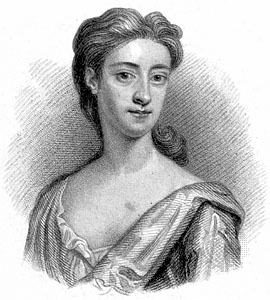
Margaret Cavendish, Duchess of Newcastle
Margaret’s arguments provide a jumping off point for Shevelow’s detailing how animals were commonly regarded in print from medieval to later 17th century times. What has been used against them from the beginning of writing is they don’t talk (“dumb animals”). Thus it was easy to assert theologically they have no souls, are not rational, despite manifesting many emotions like humans they were said not to feel these for real. The world was by God (or the Gods) made for people and we should use what comes to us just as we please. (The same justification was used for slavery; hierarchy for exploiting lower class people, women too.) Shevelow summarizes several treatises: Aquinas allowed that animals feel pain (good of him), OTOH, Descartes was especially mean. Some Jewish traditions from the Hebrew Bible exhorted humane behavior.
Her second chapter is the densest in the book about showing the way people tortured animals for enjoyment. It reminded me of Lessing’s first chapter on how people have for centuries shot and killed cats carelessly and on sprees. The most common enjoyment was to force animals to fight to the death; to terrify one with packs of others attacking it and then rejoice in the traumatized hysteria and crazed antics of the animal. Late in the book Shevelow has witnesses in the 19th century finally testifying to how bears just before bear-baiting sessions were to come (they knew) would moan, groan, quiver and cry, would try to escape, hang back until whipped into it. One incident well-documented later was of a dog and monkey driven to bite each others lower jaws off. “Blood sports” were especially prevalent in the UK.
In case you assume all people today find these sports abhorrent or are unwilling to admit they regard them complacently, think again: listen to the tone of Darnton’s Great Cat Massacre; I finished a book last week on Chardin by a respectable woman art historian who quoted a chief of police and inspector in France in the early 19th century who found blood sports much amusing as an authority whose taste in buying prints she took respectfully and seriously into account. What can one say of human beings who set up killing fields, coerce slave-labor and run rape academies justified by their “religion.”
As might be predicted Shevelow argues (and demonstrates) that enlightenment thought first spread the feeling among a minority of people (but there) that animals should be treated humanely. Her thesis, though, is that while increasing numbers of people were willing to countenance and say generally as a principle that animals should be protected from the cruelty and violence of people, what really spread active change in the condition of the lives of animals (I almost said unfortunate enough to be) in contact with people was the real spread of keeping animals as companions — pets. She says that when an animal becomes our companion, when we start to see say Clarycat (to mention my cat)’s feelings working with our own, when we notice their individual patterns of behavior, when we what’s called anthropomorphize them (Goodall argues a loaded falsifying term), then the individual doing that is going to treat the animal decently. As more and more people did that, then there was a genuine building up of identification, bonding, love.

George Morland (1763?-1804): The Artist’s Cat Drinking
Shevelow’s book falls off for a time because after she has shown the barbarity of animal treatment in the 18th century, her way of “proving” that it was the spread of people really having relationships with animals as companions is through entertaining anecdotes. The problem is not that they are many of them designedly funny, but the humor comes from our and Shevelow’s perception of incongruity. The problem may be how do you demonstrate such an argument? Johnson loved animals and had several cats but Boswell quotes him as saying: “a woman’s preaching is like a dog’s walking on his hind legs.” Then she produces equivocal arguments, e.g., people regarded animals as people because animals could be accused of murder or heinous crimes and then treated as heinously as people. I had a student who had been assigned to write about Thomas More’s Utopia and casting about to look like a feminist and find feminism in this treatise came up with idea women could be enslaved too, beaten for adultery as severely as men. Gee thanks. Shevelow cites the way people regarded birth deformities as showing we recognize animal connections with ourselves as animal imagery and analogies were produced. But it equally be that the use of the animal term shows just how debased this “freak” deformity was regarded.

A 20th century photo of family life among chimpanzees
I was surprised that Shevelow did not bring up how easier travel brought people into contact with chimpanzees and orangutans (she did cite Lord Monboddo’s work) and there people acknowledged cousinship, reluctantly but it was seen. It’s seen in novels, in memoirs, Anne Boleyn refused to keep a money because it appalled her as being too like. In Graham’s last novel, Bella, he uses the shipping of orangutans to Europe because they have white irises in their eyes and flat nails and their standing posture made people call the men. She brings up zoos as putting people on contract with exotic animals but this too is so far from her companion thesis. Circuses are places where people have practiced real cruelty to animals. She appeared to have lost her way.
*************************
With “Nature’s Cry” Shevelow got back into on track, in powerful gear and the book became excellent again thereafter: Shevelow is strongest when she is producing arguments for animal rights and describing the politics surrounding this, and (paradoxically, conversely) showing the wanton (to use the 19th century term that had purchase) cruelty and horrible fun and rage people could and did inflict on animals.
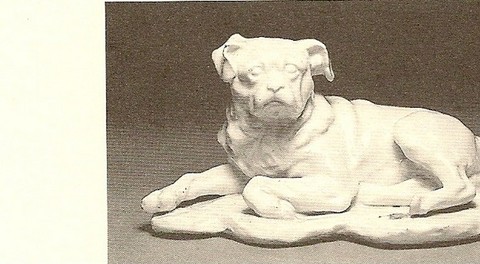
A sculpture of Hogarth’s dog — he was another man who loved animals
First, Shevelow carefully examines the most powerful of Hogarth’s allegories: the four stages of cruelty, where he shows the progress of a hero from torturing animals to killing a servant girl and along the way the four sketches have many analogous images of cruelty to animals, each showing how this behavior is pervasive in the society, usually coming back to horrific treatment of animals. Often they are small ones; cats, smaller dogs, roosters, rabbits. The point of the four is to show how cruelty to animals is part of and leads to the overall violence of people to one another. The moral lesson is one must teach children when they are young that animals have the right be treated the way a child might want to be treated. It is the first time I’d heard of this. She believes they had an effect.
She then returns to philosophers, artists, scientists, treatises and writing of all sorts showing a growing acceptance of the idea that animals have rights. Part I included ideas I assume my reader knows, Locke’s naturalistic view of the species, found also in his Thoughts Concerning Education. In Part II she moves on to writers who forthrightly produced powerful original indictments, e.g., Humphry Primate’s A dissertation on the duty of mercy and and the sin of cruelty to Brute Animals. Primate was the son of a clergyman and his became a central text of the animal protection movement, still cited today. Primate argued argued animals have the right to happiness (!) and enjoyment (companionship) just like human beings and it’s our limitation that makes us deny them this.
Those who know about 18th century medicine and psychiatry know the importance of the work of George Cheyne. He was an enormously fat man before he launched his career as a reformer and one of the thing he gave up was eating animals. Shevelow has a long chapter on his work, influence and protests. Thomas Young, another clergyman wrote an essay that achieved some readership: An Essay on Humanity to Animals; he conceded the uncomfortable truth that vegetarianism can come from not wanting to kill or hurt animals but this movement unfortunately ammunition to those who want to deny animals rights to say you are going overboard. OTOH, at the close of the 18th century and into the 19th the vivisection movement had begun and as a propaganda tool, it was effective — these experiments horrified some of those who saw them, and the feel of unnaturalness made the anti-vivisection pro-animal feeling spread.
****************************
The last part of Shevelow’s book covers parliamentary debates and teases out underlying values by tracing the kind of examples that in such debates often become electrifying litmus tests.

19th century print of bull-baiting
The first bill she says (in the history of mankind) to protect animals was introduced on April 2, 1800 by Sir William Pulteney, restrained, cautious wealthy property-developer: it was a bill to end the “savage custom of Bull-baiting.” In the debate that followed some classic arguments we hear today over gov’t’s reach, what is the function of law, can you legislate morality. I remember in the 1950s when conservative Republicans objected to social legislation on behalf of the poor as “meddling.” Never hear that now. Sheridan spoke eloquently but Shevelow shows how the emphasis was on stopping people from brutalizing themselves, and was not in sympathy with the dogs. It was too limited in scope and its focus not animals as such. It went down to defeat because the opposition was there and strong (Evangelicals are killjoys — Wilberforce was for the bill) of Wm Windham who brought out the Jacobin analogy – they are too radical against “so-called oppression.”
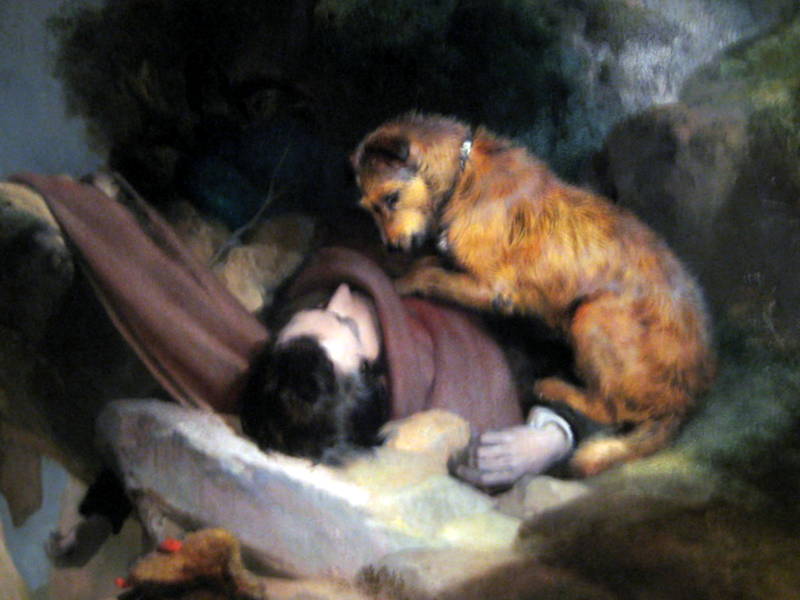
Sir Edwin Landseer, Attachment — Foxey guarding her master’s body
One of the stories which hit sore spots and became a focus of the debates (visualized by Landseer above) was of a dog who mourned a dying master and the question arose whether the dog tried to eat the master. The idea of the opponents of the bill was to show animals are not “gentle” and not worth protecting” to attack the dog was central as this domestic animal had more constituency than any others.
Shevelow briefly covers the poetry and prose of the period which encourages sympathy with others in distress, for animals, Burns’s use of the mouse, Blake, Cowper and his hares; protests poems against vivisection. Children’s books encouraged children to be kind to pets (Anna Barbauld, Sarah Hare). Blake:
A Horse misus’d upon the Road
Calls to Heaven for Human Blood.
Each outcry of the hunted Hare
A fibre from the Brain does tear.
And it was brought out by Jeremy Bentham and others that people treated their slaves as animals. She does not begin to have enough room for all the varied material she could have. The other day I read Dickens’s preface to Barnaby Rudge, which has touching portraits of two ravens somewhat comically described in human terms. I think of Lewis Carroll’s Alice refusing to eat a piece of meat once they are introduced.
A big boost was the passage of the abolition of the slave trade in 1807, and Sir William Erskine steps onto the stage. He was known as a great lover of animals, over dinner one night he even introduced his guests to his pet leeches who had saved his life. A strong successful attorney who saved the lives of several people prosecuted in the 1970s; he was gregarious, a keen wit, intelligent, and he defended one of the early whistleblower cases where a gov’t (the English gov’t) tried to put the person who revealed corruption and secrets and incompetence in jail.

1900: photo of horse left to die in a NYC slum road
On May 5, 1809 Erskine introduced “an Act to prevent malicious and wanton Cruelty to animals.” It was immediately prompted by an incident in the streets where he saw a deeply crippled, suffering starving horse being further beaten. He bought that horse, but it was just the one, In slaughterhouses it was common for horses to start eating one another out of trauma and distress and hunger. What distinguished his bill was it was not about humans but about preventing cruelty to animals. He did not seek to teach human beings to be better or end any particular practice but stop “malicious and wanton cruelty” and he maintained magistrates would recognize that when they saw it. His focus was on working animals, especially horses (treated very badly as race horses Southey maintained).
The quality of people’s petty minds against him is caught up by this doggerel:
For dogs and hares
And bulls and bears
Let Pulteney still make laws,
For sure I be
That none but he
So well can plead their cause.
Of all the house,
Of man and mouse,
No one stands him before,
To represent in Parliament
The brutes, for he’s a boar [bore]
Now the debate engaged the issues involved directly Erskine tried to make prosecutions fall on masters and owners of working places. Erskine won in the house, but went down to defeat in the Lords and the opposition was once again led by Windham who had modified his stance somewhat: he acknowledged the suffering of animals was terrible, but the particular incidents fought over show that the people arguing were talking about the human beings involved and did not take seriously the idea that an infliction of an injury on an animal should be called a criminal offense.

A blind cat taken care of in an animal shelter
On the Net recently a veterinarian (great fool) photographed herself killing a cat (for pleasure, including the cat’s terror); she has been prosecuted. I fear the man who killed the lion was not. I believe all hunting of animals should be outlawed. That all places manufacturing meat for humans to eat should be monitored carefully.
Pamphlets were written that circulated widely (by John Lamb a countering the idea this kind of bill was “a dangerous precedent”) and in Liverpool the first society for the prevention of cruelty to animals was started, had noble aims but disappeared (no money, not enough people getting involved). Erskine went back to being the people’s champion, Windham died, now known as the man who protected bull baiting.
The stage is set for Richard Humanity Dick Martin. It was after Erskin’s bill failed to pass that Richard Martin becomes individually pro-active.
***************************

Colonel Richard — Humanity Dick Martin (1754-1834, Irish politician-reformer
The most effective man most responsible for getting people to support animal rights at the time was Richard Martin, a very rich Anglo-Irish man. He comes into public record first when he fought a duel with someone who had murdered a dog owned by a member of his family – to get back at the member. I’ve seen too many times in the historical record and have come across cases in my life where I’m told someone deliberately hurt (not killed) an animal to get back at its owner. The man George Fitzgerald was a violent bully, would provoke others with a cudgel, and enjoyed shooting dogs. (Boswell tells us about one of Johnson’s associates who enjoyed shooting and killing cats; Lessing opens her book on cats on such people in South Africa when she was a girl.
Martin was known for his love of animals, including oxen (working animals); he was a domineering landowner in Connemarra – thought he knew what was good for others; his father, Robert instilled in him a deep sense of the injustice inflicted on Ireland by the English; the father not only wanted liberty and equal rights for Irish Catholics but to get rid of the crippling tariffs on Ireland, the whole range of behaviors, laws and customs that made it into an exploited miserable country. He said smuggling was the result of these. He sent Richard to Harrow where he came under the influence of Samuel Parr, a “jacobinical parson;” someone with radical and romantic sympathies.
Hogarth’s insight that the desire to treat animals as having equal rights with people goes with a deep sense of justice and rights for all people is vindicated in Martin’s story politicking in the early 19th century to speak for animals. Martin traveled to Jamaica and identified with the subaltern people; he came back to Parliament and became active, married Elizabeth Vesey who he is said to have neglected (as well as his property) and she became Wolfe Tone’s mistress (the children’s tutor at the time). He inherited a large beautiful estate but was no good as a businessman; none of his schemes (he tried for a copper mine) ever succeeded and he was continually in debt, having to find creditors and patronage. He was known for his great benevolence as a friend and master. He was sympathetic to the Irish Catholics especially during the attempt to throw off the English in 1798 and somehow managed not to be himself accused of treason; he went for compromise as did other Irish people since famous (Daniel O’Connell for example) and was for the union, and when he got to London to the parliament and saw how corrupt it was, he was taken aback, and regrouped to enlist people to help him.

Julien Dupre — a painting of a cow at pasture in a poor farm
Now Martin shepherded yet a third bill, May 24, 1822 introduced to the parliamentary floor against “the Ill Treatment of Cattle.” The arguments against this are those we hear today (though muted). Still, what was happening was a gradual change in sentiment so if you saw a man deliberately shoot out the eyes of a horse, you were horrified and tried to save the horse by killing it outright. Tellingly during debates it usually seemed as if the animal rights people were in a real minority, but when it came to a vote, again and again surprisingly more and more people would vote for this legislation. It was finally killed and again the Lords — the great obstruction for all sorts of decent social legislation.
And again there is a good insight; Shevelow now adds to her insight that the development of real companionship between people and animals heralds the first real work for improvement for animals’ lives; the second wasthe spread of cities, of people living in close proximity: like TV in the US where we watched in the 1960s cops whipping and hosing black people, beating them up, and again recently spray painting them with some terrible stuff and now simply murdering them viciously, enough people have better instincts and a sense of their own safety to protest.
Shevelow gives examples of the kind of thing seen in streets and reported during parliamentary debates. For example, a man shooting the eyes of a horse would not have been seen by many before cities; mulitiply such incidents even daily on working animals and you have another pressure not to give animals equal rights, but at least stop this kind of horrific behavior which human beings (we and they knew) are capable of doing to one another.
When Richard Martin got up to defend and argue for his bill, he described in detail particular instances of wanton cruelty — as I read these I can hardly repeat them. One concerned a monkey and dog driven to bite each other’s lower jaw off. Another was an early first description by someone with some decency of how a bull acted and felt before baiting. The person said the bull recognized signs it was about to happen and would moan and groan and shiver and look afraid. The bull dreaded this and didn’t want to do this at all in a intense way. As Martin told his stories, many members of parliament laughed. He impugned them for laughing but they laughed all the harder and no one stopped them.
And yet finally the bill was passed on July 22nd by a substantial margin. Many members sitting quietly when the mockery of Martin was going forward nonetheless voted with him. The Ill-Treatment of Cattle Act, the world’s first protective legislation for animals became a reality.

A comic print of Martin bringing a man to trial for savagely beating his donkey
Now of course one had to enforce it. She has a sort of gift for humor — she needs it, and ends on Martin’s almost single-handed crusade to get the laws enforced. He went about the streets and wherever he had wind of a cruel event and had the person indicted. Martin would pay part of people’s fines because not too would hurt working class people unfairly. Martin hated how the upper classes said he was hurting the entertianment of the lower orders when they attended the same events and were just as cruel during their own.
Now an obstacle to indictment was the law was just about cattle and judges while seeing horrific cruelty to dogs say could do nothing. But if you said you wanted to extend the protection to other species, you’d get mocking rejoinder, next thing he’ll want to protect cats. Until recently cats have not been seen as worthy as dogs since they neither protect nor can they be guide cats for say blind people. The ploy to stop legislation continued to be to say in reply something absolutist so that the small step you wanted would be thrown out.
************************
At this point Shevelow’s book suddenly draws to a close in a kind of huddled ending. The fight goes on. There is a final coda on the origins and early development of the SPCA and ASPCA. Temple Grandin and Jane Goodall get a look in as people who had done unusual good for working animals and those we eat and fighting the horrific abuse that goes on in experimentation — it’s easier to pass protective legislation for pets and animals in zoos. She reprints important parts of the text of Martin’s Act, there are extensive notes and a good bibliography.
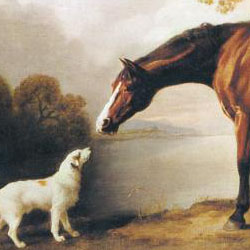
Detail from George Stubbs’s Bay Horse and White Dogs (18th century)
Progress is slow. One night walking in Old Town a few years ago Jim pointed out to me a dog who looked terrified of his master, who quivered before that man and said we could do nothing for the poor creature. When a teenager, I saw a teenage boy drop a cat from a roof. My daughter, Caroline, rescued two cats who had been abused (one would gnaw part of her stomach). There’s also plain neglect.

Philippe Mercier, Girl holding a cat (1745)
For the last couple of years of Jim’s life we made a habit when we would go to an art exhibit of seeking out depictions of cats in the paintings — or any other animal seen as a companion-pet we could glimpse.
In the streets of the cities I’ve lived in and read about nothing like the daily infliction of pain and miserable treatment once meted out to animals goes on. The new problem is a lot of cruelty to animals is not visible, and some agricultural industries have gotten legislation passed forbidding the taking of photos at their mass farms. They label animal rights’ activists terrorists and some of these people have been imprisoned for exposing wanton cruelty at factory farms and butcheries. At the close of her book Shevelow reprints the text of Martin’s act and offers addresses for important animal rights organizations if one wants to contribute or go over to work for them. I’ve written this blog so people will know about her book.
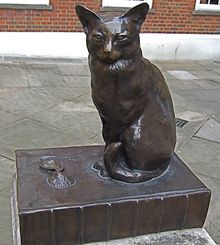
The statue of Johnson’s cat, Hodge, in Gouge Square in front of “Dr Johnson’s house”
The progress of reformation is gradual and silent, as the extension of evening shadows; we know that they were short at noon, and are long at sun-set, but our senses were not able to discern their increase — Samuel Johnson.
Ellen


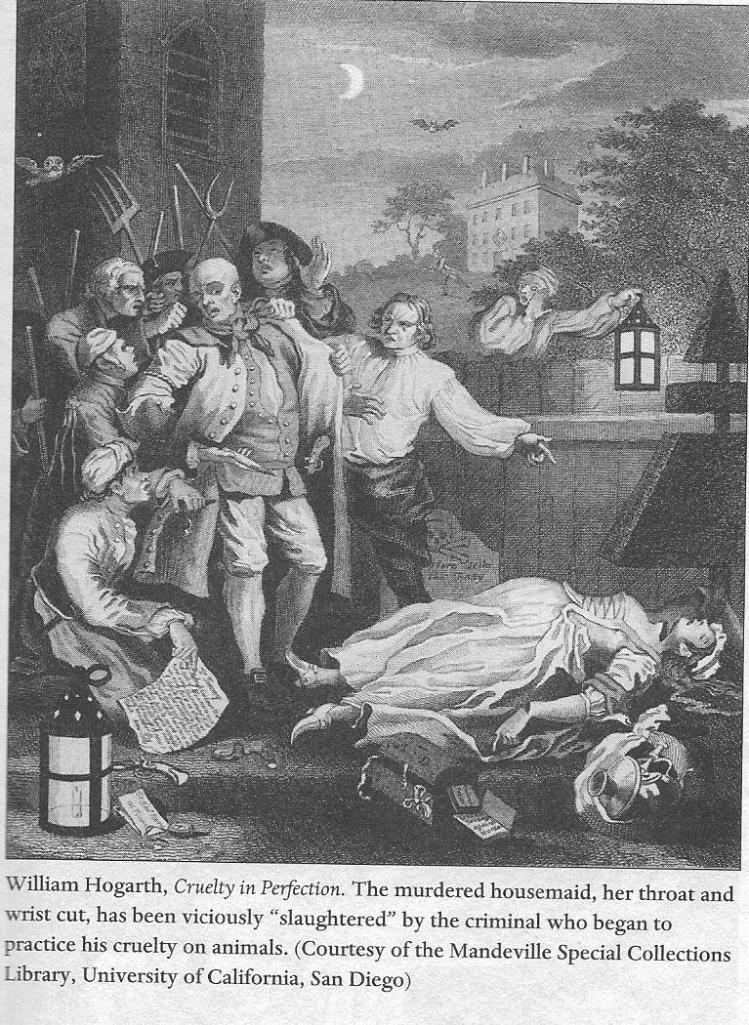

If I have my dates right, concern for animals predates concern for children by some years. Weren’t there laws against mistreating horses before there were some against mistreating children? The first royal society for prevention of cruelty to animals was in 1824. Though people had complained about sending children up chimneys from the 18th century, nothing much was done about them until after 1824.
Nancy
That’s a good question, Nancy. Even now it’s hard to widen the purview and made effective the enforcement of laws against child abuse.
My guess is people don’t care about animals personally as much. That should make them pass legislation to protect children, but they also want to use the children they feel they as parents/relatives “own.”
Shevelow brings up the socially progressive legislation that was part of what was debated with animal protection — on behalf of abolishing slavery, about (in the 19th century) treatment of workers and their pay. You are right that she neglects child abuse; also abuse of women. Perhaps she had too much material and thought these topics are taken care of elsewhere.
See my autobiographical matching response to Jenny Diski’s What I don’t Know about Animals: memories of pets over the years:
From Victoria:
These link Darwinanism to the spread of respect for animals and animal rights:
Hilda Kean, Animal Rights: Political and Social Change in Britain Since 1800 (2000)
Lee, Michael Parrish. “Reading Meat in H. G. Wells.” Studies in the Novel 42.3 (2010): 249-68 (post-Darwinian connections between non-human animals and animals leads to the rise of vegetarianism and anxieties that eating meat was akin to cannibalism).
Keith Thomas’s approach in Man and the Natural World: A History of the Modern Sensibility (?1985) suggests “the older Christian view of human responsibility and stewardship for the care of God’s creation could have been, at least partially, responsible for increased sensibility in the treatment of animals. There is “a wonderful 18th century quotation (decidedly pre-Darwin) in which it was reckoned that someone had ‘Methodist’ tendencies because during a conversation, he got up to open the window and let out a moth! The part possibly played by an evolutionary mindset is nevertheless a great line of enquiry… ”
On Cock-fighting as a “sport:” “Blood Sports in Victorian Cumbria,” The Journal of Victorian Culture,, 19:3 (2014):278-94: “In Cumbria, attitudes about animal cruelty were conflicted: for most Cumbrians, the problem with cock-fighting was not cruelty but disorder, gambling and drunkenness. Even among the magistracy there were those who did not consider cocks tearing each other to shreds as cruelty.”
Pireddu, Nicoletta. “Between Darwin and San Francesco: Zoographic Ambivalences in Paolo Mantegazza, Ouida and Vernon Lee.” Gothic Studies 16.1 (2014): 111-27.
Black Beauty… Kristen Guest’s just-published Broadview edition of Sewell’s novel—and Keridiana Chez’s recently published edition of Margaret Marshall Saunders’ Beautiful Joe. Both editions include a wide variety of background documents on attitudes towards and treatment of non-human animals in Victorian times.
Our Fellow Creatures: Who Were They? Who Are They? http://papers.ssrn.com/sol3/papers.cfm?abstract_id=2528346
Leaving the ‘Other’ Out: Lewis Gompertz, the Victorians, Other Animals, and Us http://papers.ssrn.com/sol3/papers.cfm?abstract_id=2297095
‘Your Suff’Rings, Sinless Things’: Changing Attitudes Towards Non-Human Animals, and the Cattle Plague of 1865 http://papers.ssrn.com/sol3/papers.cfm?abstract_id=2491244
(Janet Hamilton’s very interesting poem on the cattle plague is largely the focus of this
In Oliver Twist (Chapter 3) where the horrible chimney sweep boss Mr Gamfield is passing the workhouse in which the poor starving and recalcitrant Oliver is locked up.. he sees a poster offering Oliver for sale, and halts the donkey pulling his cart … the sweep’s treatment of his donkey says EVERYTHING about him: every reader knows for certain he is villainous. But most interesting is the way Dickens conveys it, almost taking us inside the Donkey’s perception. It is beautifully and graphically written.
Wilkie Collins’s Heart and Science (1882-83), which is an antivivisection novel about a doctor cutting the heads off of dogs while they’re alive to observe their brains. There is little actual vivisection shown in the novel, but we do get a very sad scene when the antagonist of the novel, Dr. Benjulia, releases a dog he had been operating on. The description is heart-wrenching. A dog is also run over by a carriage at the beginning of the book, reported in an as-a-matter-of-fact sort of way. One character suggests euthanizing her son’s cat so she won’t have to take care of the cat while the owner is away. Collins consulted Frances Power Cobbe in order to write Heart and Science.
Braddon’s Aurora Floyd: “The heroine is likened to a lot of animals (especially to tigresses), but there’s a powerful scene of horsewhipping in which the whip is turned on the animal’s abuser. Also … Ivan Kreilkamp’s “Petted Things” (on Wuthering Heights) [The Yale Journal of Criticism 18.1 (2005) 87-110] or Elisha Cohn’s “No Insignificant Creature” (on Hardy), Nineteenth Century Literature, 64:4 (March 2010):494-520. Cohn’s new book, Still Life: Suspended Development in the Victorian Novel, too.
Anna West’s essay “The Woman and the Dog: Moral Sense and Moral Agency in Far from the Madding Crowd,’ Thomas Hardy Journal, 29 (2003) — comments on the stoning away of the dog who helps Fanny Robin find her way to the workhouse, concerns the link between women and animals, both covered by the term ‘creature’, in Hardy’s novel.
H.G. Wells’s The Island of Doctor Moreau, in which the eponymous doctor tirelessly (and ruthlessly) works on a (belatedly feminized) puma for most of the novella. There are definitely some discussions that relate to New Woman, feminism, antivivisectionism, etc. Not to mention the fact that the location of Moreau’s island is very near the Galapagos Islands. Mona Caird and Sarah Grand refer to the women in a patriarchal England as akin to the vivisected animal, specifically a dog.
Finally, anything having to do with the Ferrier court case in 1881.
Monica Flegel’s provocative new book, Pets and Domesticity in Victorian Literature and Culture: Animality, Queer Relations, and the Victorian Family (Routledge, 2015).
1.) Turner, James. Reckoning With the Beast: Animals, Pain, and Humanity in the Victorian Mind.
(Turner actually contains a chapter–“Man Becomes An Animal”–very explicitly devoted to the ways that Darwin’s ideas changed Victorian thinking about the treatment of animals.)
2.) Ritvo, Harriet. The Animal Estate: The English and Other Creatures in Victorian England.
(A classic study of the cultural significance of animals in Victorian England.)
3.) Brown, Laura. Homeless Dogs and Melancholy Apes: Humans and Other Animals in the Modern Literary Imagination.
(Not at all exclusively Victorian, but valuable if your students are looking for examples of pre-Darwinian literary works devoted to imagining animal lives, like Keeper’s Travels in Search of His Master, The History of Pompey the Little, etc.)
4.) Gates, Barbara T. Kindred Nature: Victorian and Edwardian Women Embrace the Living World.
(Great literary history of Victorian natural history and other genres devoted to the describing and narrating the nonhuman, with a more or less exclusive focus on women writers.)
The books treated above argue that the essential step in the animal rights movement (an actuating cause) occurred when people began to treat animals as their companions, that is make an emotional investment in them and their lives.
Not overtly scientific but more scholarly, philosophical and informative than its title conveys is Jenny Diski’s What I don’t Know About Animals. It conveys where people actually pick up their earliest attitudes towards animals and argues for that the perception of the “otherness” of animals and how respecting and leaving room for this otherness to flourish another central emotional or intellectual step is part of how we do give them rights to good lives for them.